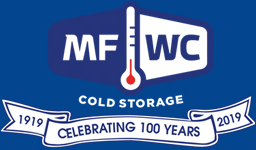In any food processing setting, it’s critical to maintain an organized work pattern to protect food quality, overall sanitation, and worker safety. If a facility can protect the chain of import, storage, and export while meeting international food safety standards, it can support a quality global food system.
Minnesota Freezer Warehouse Company is dedicated to being a part of that global food system as a climate-controlled warehouse in Albert Lea, MN. Because our warehouses are located on key shipping lanes directly between the east and west coast and both U.S. borders, we process and store products for communities worldwide. An important part of how we import, store, and export quality dry, refrigerated, and frozen food products and other perishables is our cross-docking system.
Because our warehouses are located on key shipping lanes directly between the east and west coast and both U.S. borders, we process and store products for communities worldwide. An important part of how we import, store, and export quality dry, refrigerated, and frozen food products and other perishables is our cross-docking system.
Cross docking is one of our warehouse team’s tools for processing new shipments into our current storage or for organizing a transfer in shipping lanes and carriers. The basic format of cross docking is to take an arriving shipment of products, identify the product type and quantity for inventory records, resort the product into an economic organization for our facilities if it isn’t already in an ideal package, and prepare that product for storage or export.
Identification: In the MFWC climate-controlled warehouse system, we keep highly detailed and rigorous inventory records with barcode tracking and to-the-minute information. Because we emphasize inventory tracking as a key component of good warehousing practices, the identification of a new shipment is the start of our cross-docking process as well as any of our other storage procedures. Identifying new shipments not only helps us keep clean inventory records, but also continually gives us information about how each product type ships safely and efficiently, how our suppliers operate, and how to streamline storage and export depending on product types.
Sorting: As a climate-controlled warehouse, we understand the importance of correctly sorted goods. To store or export shipments effectively, we need to sort imports and take into account how those specific products should be stored or exported and how their storage or export will affect all the other products currently in our warehouse system. This means eliminating cross-contamination, processing new shipments in a time frame that won’t compromise temperature, and organizing products to ship in the most efficient way in regards to shipping lane, carrier, destination, product type, and climate requirements.
Inbound and outbound: Whether a product will spend time in our storage or be prepared for export right away, we need to take into account our current inbound and outbound schedule. Cross docked products need to be incorporated into our current shipping and storing schedule to protect the cold chain and continue overall product movement without exposing it to unwanted climate conditions. To ensure food safety practices, we keep a close eye on our inbound/outbound schedule and work to seamlessly incorporate cross docked shipments into an ideal downstream delivery system.
To learn more about the role of cross docking at our climate-controlled warehouse in Albert Lea, MN, contact MFWC at (507) 373-1477 or info@mfwc-cold.com.
